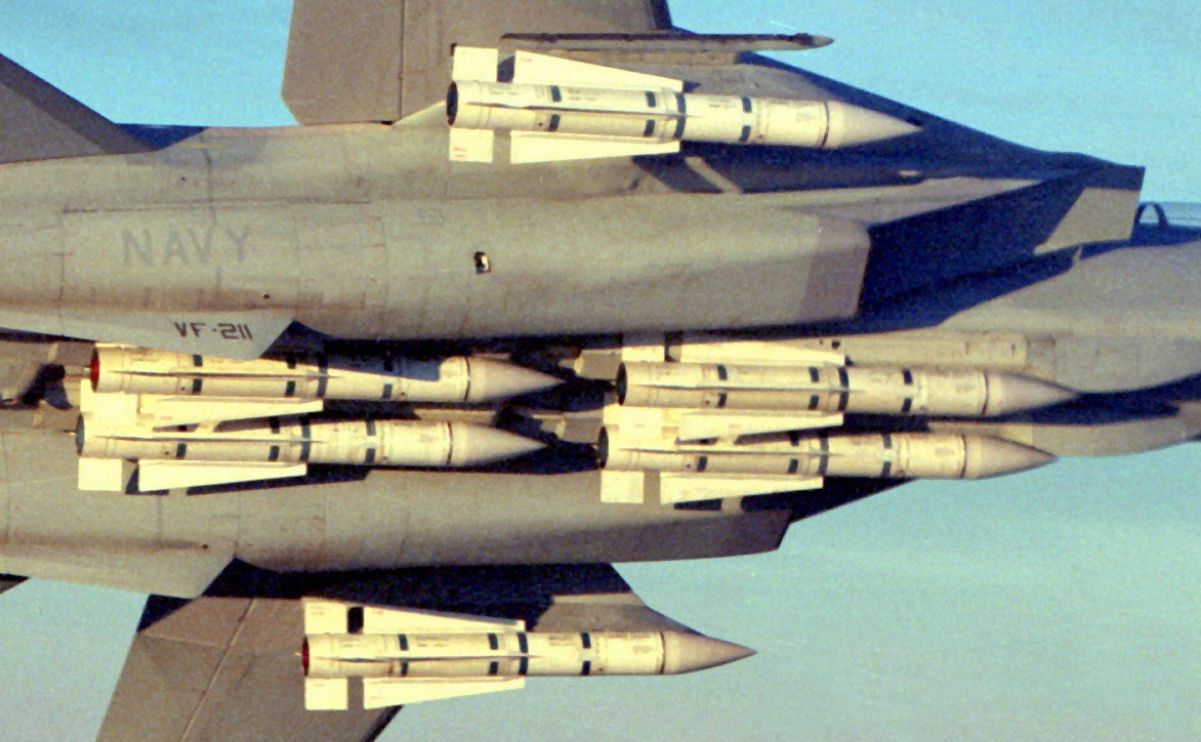The AIM-54 Phoenix
The AWG-9 weapons control system and P&W TF30 engines were used by the F-14A Tomcat, which was built in 1968 to replace the controversial F-111B, which was being developed for the US Navy’s carrier fighter inventory. The F-14A Tomcat also carried the six AIM-54 Phoenix missiles that were meant to be installed on the F-111B.
Six Phoenix missiles could be guided by the F-14 at long range against six different threat aircraft thanks to the AWG-9. Four missiles, plus two under glove stations, can be carried beneath the fuselage tunnel of the Tomcat on specially designed aerodynamic pallets. Six Hughes AIM-54 Phoenix missiles full-loaded along with the special launch rails constitute around 8,000 lb (3,600 kg), or nearly twice the weight of Sparrows.
Landing an F-14 Tomcat with a full load of six AIM-54 Phoenix missiles on the aircraft carrier
Was it therefore possible for an F-14 carrying six AIM-54s to land aboard the aircraft carrier given the Phoenix’s (heavy) weight?

Launched on June 30, 1984, from NAS Pt. Mugu, a Tomcat piloted by Lt. Ed Riley and RIO Lt. Scott Lamoreaux from VX-4 carried six AIM-54C missiles trapped aboard the USS Constellation (CV-64) after launch. Operational suitability and operational effectiveness had to be established during operational testing (OT) as part of the AIM-54C OPEVAL, and that involved obtaining a significant number of captive carry-cats and traps aboard a carrier. This was achieved by exposing Tomcats equipped with numerous loadouts of AIM-54C missiles to the carrier environment over two years before they shot in a variety of scenarios to demonstrate their continued reliability under the stresses of carrier operations.
Riley explains in the book Half Century, Baby! by David ‘Hey Joe’ Parsons and Mads Bangsø;
‘So, the question of ‘why’ gets asked regarding a loadout of six Phoenix missiles, due to urban legend that it is not practical off the boat due to fuel remaining at Max Trap. […]
Flying multiple cross-country flights with the six Phoenix/two Sidewinder loadout
‘I had flown multiple cross-country flights, accumulating over 20 hours of flight time with the six Phoenix/two Sidewinder loadout, and to prepare for this CV landing, a regular bounce workup with various loadouts including 6+2 missile loadouts was accomplished and handling qualities at the heavy loads were explored. Particular attention was paid to ‘in-close wave off” and potential ‘bolter’ technique.
‘It was decided that a Case III straight-in approach to the trap with enough fuel to return to Pt Mugu would be used. Knowing that the Tomcat would be ‘trick or treat’ on the ball, a dedicated A-7 tanking aircraft was available to assist if required, to rendezvous and pass enough fuel for a second try. In addition to the landing, the maximum weight takeoff ‘cat shot’ was of equal importance. Full afterburner catapults could be a dicey situation if a burner blowout or a stall with the TF30 engines was encountered at maximum weight. Proper technique and early identification and application of the right controls were absolutely required to successfully fly away.’

Doomsday loadout: a rare event
Riley continues;
‘The question of who should fly the flight caused some discussion within the ranks of the pilots and RIOs at VX-4 at the time. The OPEVAL Operational Test Directors (OTDs) wanted a representative fleet crew and not just more experienced operators.
‘Since I (Lt Ed ‘Dragon’ Riley) and Lt Bill ‘Kato’ Nevius were the Co-OTD team conducting the OPEVAL, it was decided to go with an experienced pilot and a RIO with less experience in the F-14. I had over 1,500 hours in the F-14A and over 400 traps (300+ on CV-64). Lt Scott ‘Scooter Lamoreaux was a very experienced RIO in the F-4, but had less than 100 hours in the F-14A and this would be his first trap in the Tomcat.
‘The operational test crew was aware that landing with six Phoenix was a rare event, however, the tactical significance of this flight was potentially a ‘real world’ requirement (known as the Doomsday loadout). Getting the maximum number of Phoenix missiles airborne as quickly as possible in a Fleet Air Defense (FAD) scenario had been war gamed at WEPTAC and it was determined to be a clear discriminator making a difference against superior numbers of attackers during the Cold War era.
The F-14 Tomcat with six AIM-54 Phoenix missiles was in a class by itself
‘How better to do this than use the maximum loadout capability of the Tomcat loaded with the new AIM-54C that was proving to be effective against air-to-surface missiles at 100,000ft/Mach 4+ as well as low-flying cruise missiles and the attacking aircraft platforms at long range. With the largest warhead of any air-to-air missile and kill radius unmatched, the Tomcat with six Phoenix missiles was in a class by itself.’
Riley concludes;
‘With all the preparation to make this a safe yet operationally realistic event, in the end it went exactly as planned with a successful trap (OK, three wire)/hot pump/and AB cat shot and return to home base.
‘To answer the question of the viability of carrying six Phoenix around the ship: sure — why not, if the tactical situation dictates?’
Half Century, Baby! is published by Mortons Books and is available to order here and here.
Photo by U.S. Navy

